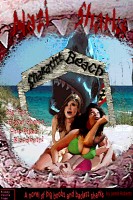Ken Russell has always been a master of excess. Characters scream and rave with large gestures; sexual immorality seems that much more immoral; passions rage to operatic heights; wild and bizarre images are jam-packed into the frames. Who better than the Wild Man of British cinema to create cinema’s most loving homage to Gothic fiction?
Gothic fiction, for those who have yet to peruse the works and words of Horace Walpole, Ann Radcliffe, or Charles Maturin, is a branch of quintessentially British literature credited as forebear of the horror genre. If the British are as repressed as they are stereotypically represented, Gothic fiction is where they escaped, filled as it is with decadence, depravity, and supernatural evils. On the one hand, there is the real decay, with crumbling mansions and castles, outdated religious views, old monasteries and churches, tombs, mouldering bones, vampires, ghosts, and so on. On the other hand, there is the moral decay of family secrets, sinful lust, sexual excesses, murders, scheming, devil worship and dabbling in sorcery, Catholicism gone wrong, and so on.
So, when Ken Russell decided to turn his attention to that special night that generated both Mary Shelley’s Frankenstein and Polidori’s The Vampyre, two seminal works of late Gothic literature, how thrilled he must have been realizing he could indulge in all the decadent tropes of Gothic style.
There is more to it than shameless visual extravagance, however. Ken Russell’s oeuvre shows a continual fascination with creative genius, usually composers. He has made films of Elgar, Tchaikovsky, Mahler, and Liszt. All of these works are a little bit libellous, a little bit scandalous, and even fly off into histrionic, hyperreal fantasies as in Lisztomania. What is clear from these films is that Russell is not interested so much in the real lives of these geniuses, but in an exploration of what makes genius tick, what makes it produce masterpieces. His worlds consequently are a strange fusion of the real life of the genius with the psychosexual undertones Russell perceives or imagines superimposed in a literalist manner. For example, Wagner is literally a vampire—and later a Frankenstein’s monster—in Lisztomania and Mahler’s wife literally makes an entire countryside be quiet so Mahler can compose in Mahler.
In Gothic, Ken Russell is focused in several creative geniuses: Lord Byron, Percy Bysshe Shelley, Mary Shelley, and John Polidori. In real life, Polidori was Byron’s personal physician, constantly with him. And the Shelley’s did indeed visit Byron’s riverside mansion one night. That night did indeed result in both Frankenstein and The Vampyre (which created the vampire genre, incidentally).
Like his other works, Ken Russell does not care to show his geniuses sitting by the fire telling ghost stories. Instead, after some set-up revealing the relationships amongst the characters and their individual psychoses, they indeed begin to tell ghost stories, when suddenly, thanks to some opium no doubt, all of their moral decadence bubbles to the surface and real horrors invade Byron’s mansion. That’s when the fun begins.
The result is an hour of non-stop Gothic motifs. There are scenes with sex orgies and nudity, spider webs, masochistic self-abuse, a monster in a barn, thunder and lightning, a beast in a knight’s armour, séances, skulls, animatronic dolls, leeches, and more.
Whether Ken Russell’s deviant fantasies really go any way to explain the creation of Frankenstein and the vampire is open to debate. However, he certainly gives it a try. Polidori is a conflicted homosexual in Victorian society, who watched the way Byron seduces women with both revulsion and desire. The modern vampire is Russellian reimagining of Byron. Frankenstein is a little more complicated, involving a miscarriage and speculations about life and death.
For horror fans, the film offers some wild imagery equal to anything in the equally incoherent Fulci, though without the gore. More interesting, however, is that it may be the only truly Gothic movie. There was no cinema in the era of Gothic fiction. While Gothic fiction begat the horror genre, it was not itself concerned with grisly deaths, as much as what the characters witnessed. You know these characters are not going to die. There will be no grisly deaths.
This, combined with the subject matter of Shelley and Polidori, makes the film an investigation into the beginning and nature of horror itself: What is horror? What does it come from? Why does it affect us the way it does? While this means horror is treated more abstractly in Gothic than in most horror films, it is worth greater consideration and attention from the genre’s fans.
Help make this site more interesting through discussion:
Gothic (1986)
Author: Jared Roberts
Subscribe to:
Post Comments (Atom)

0 comments:
Post a Comment